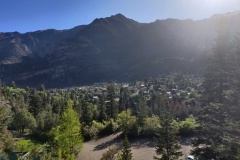Mountain towns and Pueblo villages
I had a leisurely day planned for today. I would be heading south on the US 550, popularly known as the “Million Dollar Highway” and making stops at a few towns along the way.
The highway is so named because of the millionaires that had been minted as part of the silver mining a century ago. Nowadays, the name is also synonymous with having million dollar views of the San Juan mountains.
My first stop of the day was in Ouray. I took a short hike to see the Box Canyon falls, where Canyon Creek gets forced through a very narrow part of the canyon and crashes down 85 feet. Since I was there just as soon as it opened, I largely had the falls to myself.
Ouray itself seemed like a nice town, but I didn’t linger, choosing instead to head further south over a couple of mountain passes to Silverton. Though Silverton in its heyday was a major hub for mining, you would think now that it’s stuck in time (deliberately, I think). Only the main road is paved, whereas other roads in town, including the notorious Blair Street, are dirt roads, with turn of the century buildings (or newer constructions meant to look like turn of the century buildings). Blair Street is notorious because at its height, there were 23 saloons and other businesses of disrepute all in a 6 block stretch. Brawls and disorderly conduct were common. In one particular instance the town marshal was killed.
I continued down the million dollar highway culminating in Durango. This is a bigger town with lots of shops and restaurants, but the big draw is the narrow gauge railway. Steam powered locomotives take tourists up through the San Juan mountains on a scenic journey. I was not interested in the trip itself, but I did visit the train station, museum and roundhouse where mechanics were busy at work maintaining the ancient engines.
As it was only just after lunchtime at this point, instead of heading directly to Cortez, my destination, I opted to go to the Mesa Verde National park, which I had originally planned to do tomorrow. The park features dwellings, including pit dwellings (dug slightly into the ground), surface dwellings, and most famously, cliff-side cave dwellings dating from about 600-1300 AD. Apparently, the inhabitants would farm the soil on the top of the Mesa (which is like a flat short mountain), and then lived below ground in the canyon walls so they could keep warm in the winter and cool in the summer. They would climb up and down the canyon walls, between their residence and the farm above using only foot and handholds. It was fascinating to see such ancient history right in the United States.
After the visit I made my way to Cortez to have some dinner and find my hotel.


















